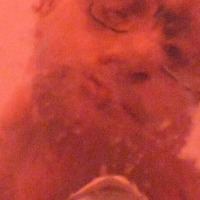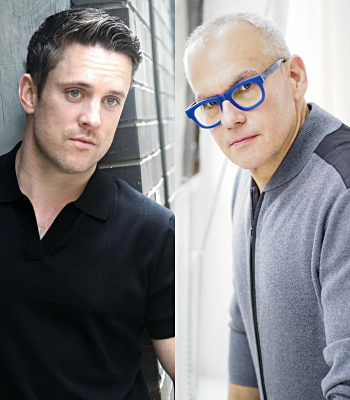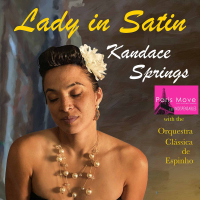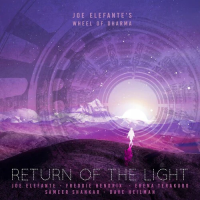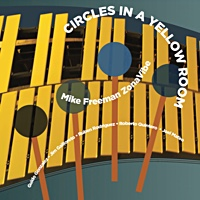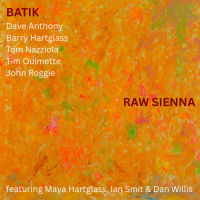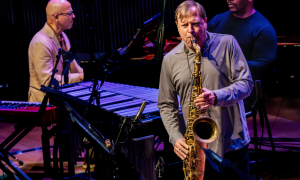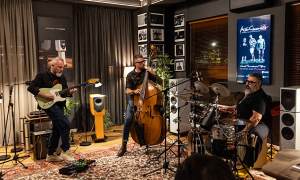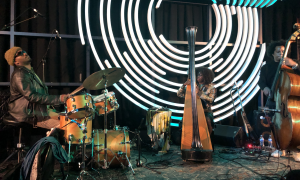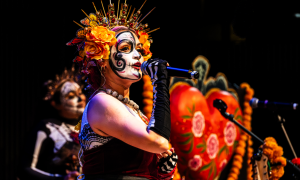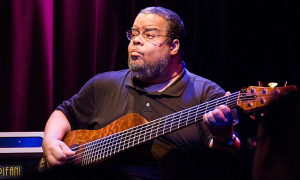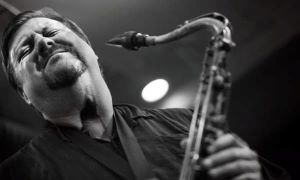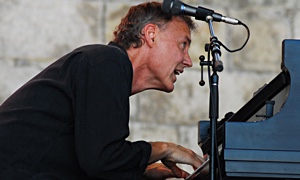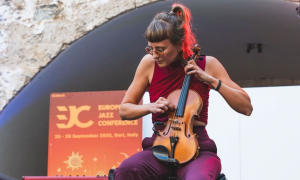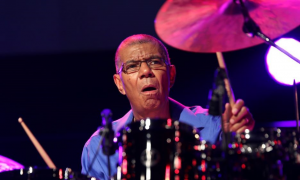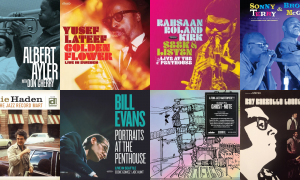Home » Jazz Articles » Live Review » Jazz Middelheim 2009
Jazz Middelheim 2009
Park Den Brandt
Antwerpen
Belgium
The Jazz Middelheim festival is nearing its fortieth anniversary, but it's a weekender that hasn't relinquished a fondness for adventure. Nuzzling up against its stellar bookings are acts, Belgian and otherwise, who seek to jolt the expectations of many audience members. The entertaining middle way is subverted by the sideways thrust of jazz extremity. This, too, can often be entertaining. 2009 is the second year that Bertrand Flamang has been in charge of organization and programming. He's already known for nearly a decade's sterling work running the nearby Gent Jazz Festival, and has rapidly established a house style at Jazz Middelheim.
There's a similar format, in terms of stylistic contrasts, timing structure, food vendors and Belgian beer range. The main practical difference to the Gentfest is that the marquee stage is more integrated with the landscape of its park setting; all of the bars, stalls and food outlets ranged in a roughly circular fashion around the festival's musical heart. It's possible to sprawl on the lawn and still enjoy a (distant) view of the performers, should such a casual engagement be desired. If choosing to sit up close, an early arrival is advised, as attendance is gratifyingly swollen, even in these hard times.
August 13: John Zorn, Lou Reed, Laurie Anderson/Flat Earth Society/Octurn
To open: a pair of Belgian big bands, both of whom operated on an upward curve of innovation. Octurn formed in 1996, and is an adaptable unit, changing its make-up to suit particular projects. This time, the horns were emphasized, but perhaps that's always the case. Saxophonists Bo Van Der Werf and Guillaume Orti pen most, if not all, of the compositions for Octurn's large forces. There was a broad range of colors on display, but ultimately the pieces needed more passion, coming across as being too tidily arranged, and neatly delivered, particularly when compared to the unfettered dynamism of the immediately following Flat Earth Society.
This was an even bigger assemblage—even heavier on the horns—kept tautly on the reins held by reedman Peter Vermeersch, but given great amounts of slack each time they delivered the payload of a tune's governing theme. After this, anything could transpire, and usually did; the soloists bounding around the stage-space, crazed by their sudden release from confinement. Veermeesch reveled in tune titles that combine evocative imagery with poetic expression, none more so than his "Vole Sperm Reverie." The Flemish taste for theatrical seriousness abounded, the ludicrous breeding with the complex, the lofty academy-of-the-head crumpling into a pair of involuntarily-soiled crimplene slacks. It would be dishonest not to mention Frank Zappa, Anthony Braxton, Willem Breuker and Captain Beefheart.
Lou Reed and John Zorn played their first gig at The Stone, a New York experimental joint operated by the saxophonist. This was in January of 2008, severely stretching the capacity of a space that can just about contain 73 punters. Laurie Anderson was their special guest on that night, and here that threesome was reunited, this time performing in front of a thousands-strong throng, seemingly a one-off festival exclusive for Jazz Middelheim. Reed and Anderson are to play subsequent European dates, but without Zorn. When Reed and Zorn met again at New York's Poisson Rouge club in November 2008, the target was eardrum destruction, with the pair in a highly aggressive state that didn't waver all night. Reed churned and Zorn caterwauled, to ripping effect. The addition of Anderson might be a factor in this gig's greater lyrical content, as she's fond of crafting layered electro-violin washes, often disguising her output by making sonic processing tweaks.
For the first thirty minutes or so, the trio flailed around, attempting to locate the sometimes elusive coalescence of improvisational magic. It was Zorn who primarily took the lead, frequently turning up a new direction as he graduated from compressed squawking to open bebop grace, then reverting that same flow. Reed appeared the most unfulfilled, riffing sluggishly and failing to connect. This is the big risk of free improvisation, particularly when taken in front of a huge (and hugely expectant) festival audience. Around halfway through the set, all three suddenly intersected, catching onto a simultaneous energy. The hypno-riffing locked, built and burst, with Reed even singing primitivist fragments at one stage, before ditching his guitar and triggering grimy samples on his mixing desk/keyboard. Zorn was both technician (gloriously precise shrieks) and hysterical intuitive (gloriously throttling bell-into-inner-thigh glottalisms).
This was a divisive performance. Even punters who have obviously turned out on the strength of these star names (either one, two or maybe even all three) were drifting off impatiently into the night, presumably displeased by such experimental antics. What did they expect? The majority, though, were transfixed, and ultimately enthusiastic, rewarding this now-laughing sternoid three for their extremely involved noise-sculpting session. Yes, Zorn and Reed were looking remarkably cheerful, a demeanor that was already expected from Anderson.
August 14: Dee Dee Bridgewater/Hans Teeuwen/The Erik Vermeulen Trio
Here's another strength of this festival: an opening night of extremity, followed by a complete mood-change towards singing accessibility, although the second evening began with the instrumental calmness of the Erik Vermeulen Trio. This old-timer Belgian pianist was well-situated, acting as a thoughtful opener to the more strident vocalizing that followed. Vermuelen emerged from a classical background, subsequently devoting himself to jazz composition. He didn't stir up any riverbed mud; instead, he was adrift on a lily pad, calmly negotiating luminous themes, demanding a particular concentration from the audience. At this relaxed opening stage of the proceedings, they were able to offer the required concentration—it was hard to avoid listening to this set without placing it in a relationship with the entire evening's program.
Dutch singer Hans Teeuwen easily earned the distinction of being the festival's worst performer, even though, on one level he was actually quite skilled in certain areas. Teeuwen is chiefly known as a comedian, only launching his jazz/easy listening career in 2006. He has a problem, however. His entire body language, his complete garb and hairstyle were obsessively stolen from singer Nick Cave, down to the last frighteningly authentic detail.
Well, apart from his voice. Bizarrely, Teeuwen's repertoire and vocal style were more akin to Frank Sinatra, at least until he moved into his rockier, self-penned material, towards the set's end, his English words revealing a poor attempt at wit. Sadly, there was not a single morsel of originality in his approach. Who could be Teeuwen's intended audience? On a positive note, even though he offered nothing individual, Teeuwen was, at least, a spirited communicator, his one innovative act being to steal a camera from the photographers' pit, forcefully swinging it while he sang. Certain terminally introverted jazz singers could pick up a few useful hints, but they'd be more usefully engaged by seeking a direct conduit to Cave himself.
Just as the whole evening might have been expected to descend into mainstream jazz-vocal hell, Memphis songstress Dee Dee Bridgewater helped out by having a Latin-oriented band, featuring pianist Edsel Gomez and bassist Ira Coleman. This support lent her songs a degree of muscle and interest, or even interesting muscle. For over twenty years now, Bridgewater has been living in Paris. She bordered on the arrogant in terms of her frequent hectoring of the masses, but Bridgewater also defused this tendency by sudden attacks of self-deprecation. Consequently, it was often hard to define her stance in terms of its degree of humor—or not. She made what seemed to be a light quip, but there was often a suspicion that if the crowd didn't obey her orders, Bridgewater would lose her cool. She stalked the perimeter of the jazz songs, grabbing hold of influences from soul and Afro-Latin quarters. This (now) shiny-domed woman's voice was a powerful tool, but Bridgewater didn't neglect the qualities of melodic soulfulness.
August 15: The Toots Thielemans Quartet/Chet Mood/MSG/The Cookers
The Cookers were almost too much too soon on a sun-dappled afternoon. But who cares? This all-star combo is dedicated to the memory of trumpeter Freddie Hubbard, its name paying homage to his Night Of The Cookers, two-volume Blue Note live album from 1965. Even so, the majority of the repertoire was generated from within the group's ranks. The Cookers was a band riddled with fast-shooting soloists and boasting an unbeatable line-up, at least within the realms of sleekly-charged New York competitiveness. Trumpeter David Weiss seemed to be the driving force, but he was matched in energy level by saxophonists Billy Harper and Craig Handy and fellow trumpeter Eddie Henderson, fuelled by the rhythm team of pianist George Cables, bassist Cecil McBee and drummer Billy Hart. Harper's contributions were lava-spewing, both in terms of soloing prowess and compositional ideas.
A lengthy, inspired version of "The Court" was all that was needed to directly invoke Hubbard's legacy. Every solo was a winner, and a burst of applause was required for almost every single flash of expression. While one member was soloing, the other horns invariably punched out periodic theme statements, whipping each respective horse's flank into a spasming froth. Harper provided his "Priestess" for the final peak, once again standing out as the finest soloist amongst an already masterful bunch.
The rather boringly-named MSG is a trio featuring alto saxophonist Rudresh Mahanthappa, bassist Ronan Guilfoyle and drummer Chander Sardjoe; an international blend between various portions of Indian, Irish, Dutch and New Yorkian, depending on ethnic heritages, current residences and general musical mashing-up. Sardjoe drummed for Octurn on day one of the festival; here, his cymbal-encrusted kit loomed, as he rocketed around with a hyper-military density, bomb-crumping into infinity. Mahanthappa is principally known for his various collaborations with fellow New Yorker/pianist Vijay Iyer. His hard alto sound was like unto an Indian shenhai reed-flute, warbling as it pierced, while Guilfoyle's bass had a rubberized resilience. The music was fast, dense and rigidly constructed, but often uninteresting in its structural inevitability. It sprang out of the cerebro-funk cabinet of free-form complexity: head music without the drugs. We wanted to dig it more than we did...
The next set was to become a supreme festival highlight. In another super group formation (at least from a Eurocentric viewpoint), the Chet Mood project revolved around an appreciation of Chet Baker's repertoire, although the actual end result was floating in the general spirit, rather than being a slavish exhumation. The Italian trio of trumpeter Enrico Rava, bassist Riccardo Del Fra and drummer Aldo Romano were joined by Belgian guitarist Philip Catherine, forming a glowing assemblage of key Euro-players. The Italians were all in limber shape, but Catherine, in particular, was found in his finest form here, dazzling with the compressed passion of his soloing. He provided the chemical imbalance that set the other three off on a glimmering journey that embraced ballad sensitivity as well as a heartily chugging swing.
The driven Catherine was well-qualified for this outing, having gigged with Baker regularly in the mid-1980s. Rava let off a surfeit of crisp solos, both open and muted, whilst Romano ticked time with masterful certainty. They closed with "My Funny Valentine," which has rarely been delivered with such suppressed power, as Catherine could barely contain his urge to strum emphatically. The relationship between all four players was perfectly balanced.
It was only whilst perching in the midst of a rapt home crowd that it became clear just how immense a cultural figure Toots Thielemans is in Belgium. He's famed enough globally, but at a festival where the nearby Crowne Plaza hotel has a bar named after this octogenarian (and nearly nona-) harmonica blower, he's an ingrained presence on the musical scene. Frequently sighted sauntering coolly around the grounds, checking out new and old bands, it was clear that the Brussels-born Thielemans is plugged into jazz in all its eras and forms, keeping his fingers on the ever-changing pulsations.
This sequence of relaxed and exquisitely performed standards set the audience on held-breath alert, only exhaling when each archetypal song had reached its delicate conclusion. Also, a Thielemans definition of standards embraced some unusual choices besides the expected Gershwin, Jobim, Mancini and Monk (including a completely solo "'Round Midnight"). He also peppered the set with ditties by Dave Brubeck, Paul Simon and Jacques Brel. Thielemans can best be described as post-Larry Adler, chromatically taking the harp in a completely different direction to that chosen by the average, bluesy, gut-bucket amplifier-blaster. Consequently, his sound was full of minutely-ground glass particles, casting beautiful dust-clouds over these roseate melodies, ably supported by his regular Belgian rhythm section. It was sweetness personified.
August 16: David Murray/Charlie Haden & Kenny Barron/Jason Moran's Bandwagon/The Bert Joris Quartet
Trumpeter Bert Joris is a leading figure on the Belgian scene, and a regular booking at this festival. Apparently, back when he was a mere stripling, he sneaked in across the park's moat. Now, he's here in a more official capacity. Joris opened up the festival's final afternoon with a set of refined introversion. There were few moves towards an outward individuality, but he delivered a classy manifestation of post-Miles cool jazz, slicing softly from trumpet to flügelhorn. He was carefully balanced, but not terribly engaging.
If the search was for a unique personality, then Jason Moran was here with his augmented Bandwagon group, setting a sonic precedent with some genuinely unpredictable material. On one side of what is usually a musical divide, the pianist was writing for his wife, singer Alicia Hall Moran, gliding across from the operatic sphere. At the other end of the barrier was a band whose primary musical language is descended from funk and blues, at least for this particular project. It was not as straightforward as an operatic blues crossover, though. Moran's music contained elements of soundtrack atmospherics and precisely composed third stream jazz, whilst Hall was also required to narrate, along with an isolated tale woven by the guesting Bill Frisell.
All of this might sound like a random cocktail, but Moran directed his diverse content into an end product that had a disciplined wholeness. He also played some mean modern stride. Moran used traditional motifs, but made the fusion sound continually surprising. It was thrilling to hear Frisell play the scabbed-up blues, with Tarus Mateen fruitfully offloading an endless run of slithery bass lines. Frisell was being gently coerced into revealing yet another of his many potential styles/personalities, and one that doesn't get heard very often. Meanwhile, Nasheet Waits continued to underline his growing position as one of New York's most in-demand drummers. Alicia Hall Moran's vocalizations retained the veneer of opera, but in this unfamiliar setting, she introduced aspects of spirituals, even if sung from a position of formalized training.
The next two sets took the festival up to a heavenly conclusion. Veteran bassist Charlie Haden continues to perform in a refreshingly wide range of settings, but a duo arrangement is the best for hearing his every nuance. That was less the case when he toured with Pat Metheny, due to the guitarist's full amplifier spread, but for his Jazz Middleheim appearance he was sharing the stage with pianist Kenny Barron, who peppered his rivulets with regular spacings. The pair also observed old-fashioned alternating solo rules, and while this had a certain predictability, it also had the advantage of revealing Haden in a sometimes entirely solitary space.
No one was hurrying, and Haden relished each emphasized phrase, each fleet manipulation of his digits. He sounded quirkily eccentric in his occasional announcements, and when the set was over he let out his distinctive whoop, retaining the sheer unselfconscious enthusiasm of a nine-year-old. Barron was all over and under each tune, but he still felt like an accompanist to the central show that was Haden and his deification of space and thrum. The audience was absolutely silent, of course. Often, the Church Of Jazz can be too reverential; but when Haden's in the pulpit, his audience is a willing supplicant.
Now, what the hell is David Murray up to next? Here, he unearthed the Spanish-tinged repertoire of Nat King Cole, formed an alliance with a band of Cuban players, and added string arrangements for members of the Antwerp Philharmonic. In the late 1950s, Cole played several residencies in Havana, singing his songs in Spanish, and subsequently recorded three albums to capture this experience. It's this period that Murray was seeking to reflect. Initially viewing the show from outside the marquee, there seemed to be complete divergence between the band, the strings and Murray himself, as if this was Cole as envisioned by Ornette Coleman in a harmolodic state of flux. Upon securing a much closer seat, it was easier to become merged with the previously warring factions, probably as Murray and his collaborators (and the sound engineers) achieved some kind of balance.
Given that the entire gig sprawled over nearly two hours of massively compelling Latin freeness, these first few numbers represented only an initial teething problem. The conventional Cole songbook was bypassed in favor of tunes such as "Cachito" and "Quizás, Quizás, Quizás." This was certainly a split-hemisphere experience. The arrangements emulated the glitzy hotel bar stylings of Edmundo Ros instead of the expected Irakere vibration. But as Murray spewed virulent gobbets of free tenor gristle, such sugary string sweeps were subverted, becoming something else entirely.
At the same time, these crack Cuban soloists were coming close to matching their leader's excesses, but didn't quite make the required leap. Even so, this is a band that was packed with fiery emoters, forcing Murray to regularly raise his intensity in the name of competition. No one else has dared to dream up a formula like this, and Murray was uncompromising enough to produce a substantial program that simultaneously enjoyed the sway of kitsch exotica, the hardcore Santeria sound of Cuba, and the heady ejaculations of New York loft jazz, all on the same dance floor.
Tags
PREVIOUS / NEXT
Support All About Jazz
 All About Jazz has been a pillar of jazz since 1995, championing it as an art form and, more importantly, supporting the musicians who make it. Our enduring commitment has made "AAJ" one of the most culturally important websites of its kind, read by hundreds of thousands of fans, musicians and industry figures every month.
All About Jazz has been a pillar of jazz since 1995, championing it as an art form and, more importantly, supporting the musicians who make it. Our enduring commitment has made "AAJ" one of the most culturally important websites of its kind, read by hundreds of thousands of fans, musicians and industry figures every month.

